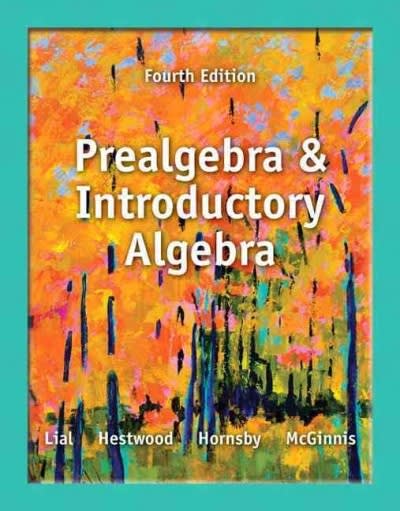Question
An environmental science professor at UNL was curious whether the majority (more than half) of students at UNL regularly recycle plastic bottles. The professor selected
An environmental science professor at UNL was curious whether the majority (more than half) of students at UNL regularly recycle plastic bottles. The professor selected a random sample of 146 students at UNL to interview, then asked each student: "Do you recycle plastic bottles more often than you throw them in the trash?" (Yes/No). Suppose that 89 of the students answered "Yes".
- Define a single observational unit. (1 pt)
UNL Students
- Define the variable of interest and its type (i.e. categorical or quantitative). (2 pts)
Whether or not bottles are recycled or thrown in the trash (Categorical)
- Define the population of interest. (1 pt)
146 randomly selected UNL students
- Define the parameter of interest in words and assign a symbol.(2 pts)
, the average amount of students that regularly recycle
- Set up the null and alternative hypothesis in plain English (i.e. words). (2 pts)
A majority of students at UNL do not regularly recycle plastic bottles
A majority of students at UNL do regularly recycle plastic bottles
- Set up the null and alternative hypothesis using symbol notation. (2 pts)
H0
Ha
- State the observed statistic and assign a symbol. (hint: Write the observed statistic as a decimal to help you with problem 9) (2 pts)
- Set up a simulation study, by filling out the blanks below, that you can use to determine whether the observed sample is unusual under the null hypothesis. (2 pts)
Probability of success : _______
Sample size : _______
Number of samples: ________
- What is the p-value based on the simulated distribution below? (2 pts)
Note: 100 values were simulated. Show your work!
- Based on the simulation above, calculate the standardized statistic (z). Show your work!(3 pts)
- Based on our standardized statistic and p-value, we would ____________ the null hypothesis. (2 pts)
- Accept
- Fail to reject
- Reject
Briefly explain why you made this decision.
- State your conclusion in context of the research question, based on your decision above.(2 pts)
- Suppose instead, the professor sampled 292 students and found that 178 students answered "Yes".
- Which one of the following changes? (1 pt)
- Observed Statistic
- Null hypothesis
- Alternative hypothesis
- Sample Size
- What would happen to the strength of evidence against the null hypothesis? (1 pt)
- Increase
- Decrease
- Remain the same
- We want to know if the proportion of students at UNL that would have said "Yes" differedfrom 0.5 rather than was greater than 0.5.
- Which one of the following changes? (1 pt)
- Observed Statistic
- Null hypothesis
- Alternative hypothesis
- Sample Size
- What would happen to the strength of evidence against the null hypothesis? (1 pt)
- Increase
- Decrease
- Remain the same
| z below -2 or above 2 | Strong evidence against the null hypothesis |
| z below -3 or above 3 | Very strong evidence against the null hypothesis |
| 0.10< p-value | Not much evidence against null hypothesis |
0.05| Moderate evidence against the null hypothesis | |
| 0.01 | Strong evidence against the null hypothesis |
| p-value<0.01 | Very strong evidence against the null |
Step by Step Solution
There are 3 Steps involved in it
Step: 1

Get Instant Access to Expert-Tailored Solutions
See step-by-step solutions with expert insights and AI powered tools for academic success
Step: 2

Step: 3

Ace Your Homework with AI
Get the answers you need in no time with our AI-driven, step-by-step assistance
Get Started


